Advertisements
Advertisements
Question
A capacitor of capacitance 8.0 μF is connected to a battery of emf 6.0 V through a resistance of 24 Ω. Find the current in the circuit (a) just after the connections are made and (b) one time constant after the connections are made.
Solution
Given:-
Capacitance, C = 8 μF
Emf of the battery, V= 6 V
Resistance, R = 24
(a) Just after the connections are made, there will be no charge on the capacitor and, hence, it will act as a short circuit. Current through the circuit,
\[i = \frac{V}{R} = \frac{6}{24} = 0 . 25 A\]
(b) The charge growth on the capacitor,
\[q = Q \left( 1 - e^{- \frac{t}{RC}} \right)\]
One time constant = RC = 8 × 24 = 192 × 10-6 s
For t = RC, we have:-
\[q = Q . \left( 1 - e^\frac{- RC}{RC} \right)\]
\[ \Rightarrow q = CV\left( 1 - e^{- 1} \right)\]
\[ \Rightarrow q = 8 \times {10}^{- 6} \times 6 \times 0 . 632\]
\[ = 3 . 036 \times {10}^{- 5} C\]
\[V = \frac{Q}{C} = \frac{3 . 036 \times {10}^{- 5}}{8 \times {10}^{- 6}} = 3 . 792 V\]
Applying KVL in the circuit, we get:-
E = V + iR
⇒ 6 = 3.792 + 24i
⇒ i = 0.09 A
APPEARS IN
RELATED QUESTIONS
Use Kirchhoff's rules to obtain conditions for the balance condition in a Wheatstone bridge.
Given the resistances of 1 Ω, 2 Ω, 3 Ω, how will be combine them to get an equivalent resistance of (11/3) Ω?
Given the resistances of 1 Ω, 2 Ω, 3 Ω, how will be combine them to get an equivalent resistance of (6/11) Ω?
Using Kirchhoff’s rules determine the value of unknown resistance R in the circuit so that no current flows through 4 Ω resistance. Also find the potential difference between A and D.
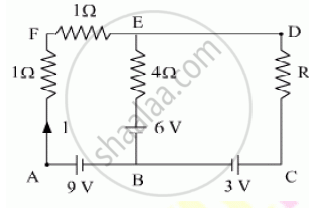
In the given circuit, assuming point A to be at zero potential, use Kirchhoff’s rules to determine the potential at point B.

Consider the following two statements:-
(A) Kirchhoff's junction law follows from conservation of charge.
(B) Kirchhoff's loop law follows from conservative nature of electric field.
Find the circuit in the three resistors shown in the figure.
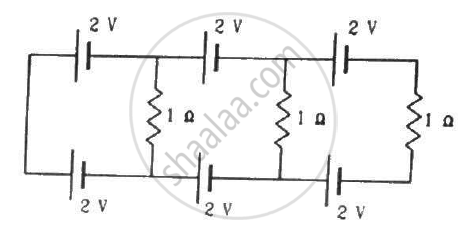
Twelve wires, each of equal resistance r, are joined to form a cube, as shown in the figure. Find the equivalent resistance between the diagonally-opposite points a and f.

Find the equivalent resistances of the networks shown in the figure between the points a and b.
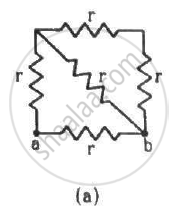
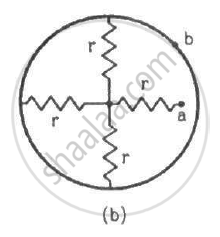
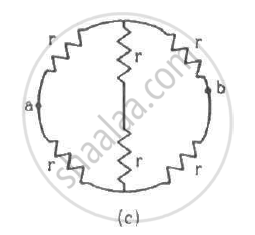
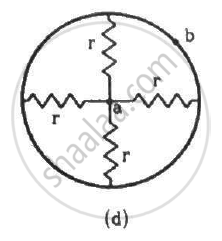
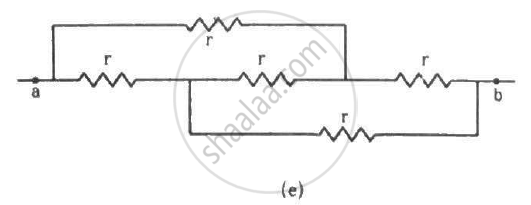
An infinite ladder is constructed with 1 Ω and 2 Ω resistors, as shown in the figure. (a) Find the effective resistance between the points A and B. (b) Find the current that passes through the 2 Ω resistor nearest to the battery.

On which conservation principle is Kirchoff's Second Law of electrical networks based?
Solve the following question.
Using Kirchhoff’s rules, calculate the current through the 40 Ω and 20 Ω resistors in the following circuit.

How the emf of two cells are compared using potentiometer?
In a potentiometer arrangement, a cell of emf 1.25 V gives a balance point at 35 cm length of the wire. If the cell is replaced by another cell and the balance point shifts to 63 cm, what is the emf of the second cell?
Kirchhoff’s second law is a consequence of law of conservation of ______.
Kirchhoff’s junction rule is a reflection of ______.
- conservation of current density vector.
- conservation of charge.
- the fact that the momentum with which a charged particle approaches a junction is unchanged (as a vector) as the charged particle leaves the junction.
- the fact that there is no accumulation of charges at a junction.
What are the advantages of the null-point method in a Wheatstone bridge? What additional measurements would be required to calculate `R_(unknown)` by any other method?
What is the advantage of using thick metallic strips to join wires in a potentiometer?
